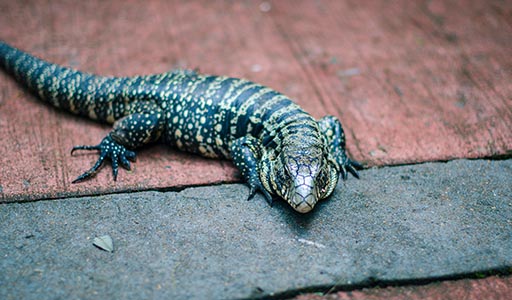Tegu Lizards

Tegu Lizard Information
Tegu lizards are large reptiles that can grow up to 4 feet long. These terrestrial lizards are typically black and dark grey and are most active during the daytime. Tegus’ diet consists of vegetables, fruits, insects, and small animals. Tegus pose a threat to birds, small mammals, and reptiles living around your property. They are not innately aggressive but will defend themselves if they feel threatened.

What does a Tegu Lizard look like?
These generously sized reptiles can grow to be four to five feet long and weigh roughly 30 pounds. Their long, thin bodies come in a variety of colors and can be gold, tan, gray, red, or white, often in a striped or speckled pattern. Tegu lizard tails have dark bands and their toes are tipped in sharp claws. The pests’ heads and necks are large and thick, with powerful jaws and pointed teeth.

What does a Tegu Lizard eat?
Their best known dietary habit is eating the eggs of birds and other lizards. Biologists fear this behavior could destroy generations of alligators, turtles, and rare birds like the roseate spoonbill. However, tegu lizards also eat a wide variety of other materials such as fruits, seeds, insects, snails, and small animals. This is problematic as well, as it makes them highly adaptable and likely to thrive.

Tegu Lizard habitats
The preferred regions for tegu lizards are dry, upland areas with sandy soil. This gives them many options in natural, urbanized, and agricultural areas. For shelter, they dig burrows or invade those already made by native gopher tortoises and other animals. They will remain underground from late fall through winter. Rare for reptiles, a tegu lizard is able to withstand temperatures as low as 35 degrees. This hardiness is concerning because it opens up a wider scope of potential territories than most reptile species can handle.


